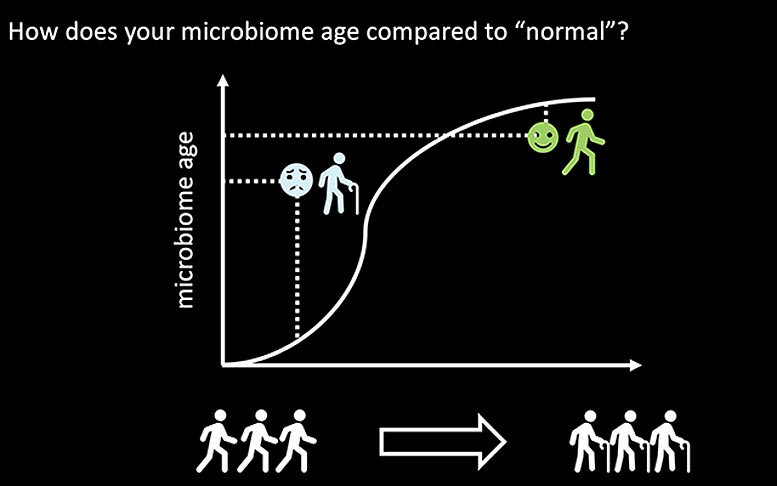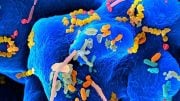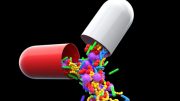
The makeup of microbial communities residing on your skin and elsewhere, your ‘microbiota age,’ can now be correlated with your biological age. Credit: UC San Diego Health Sciences
New understanding of how our microbiomes change as we age sets the stage for future research on the role microbes play in accelerating or decelerating the aging process and influencing age-related diseases.
Our microbiomes — the complex communities of microbes that live in, on, and around us — are influenced by our diets, habits, environments, and genes, and are known to change with age. In turn, the makeup of our microbiomes, particularly in the gut, is well-recognized for its influence on our health. For example, gut microbiome composition has been linked to inflammatory bowel disease, autoimmune disease, obesity, even neurological disorders, such as autism.
Given a microbiome sample (skin, mouth or fecal swab), researchers have demonstrated they can now use machine learning to predict a person’s chronological age, with a varying degree of accuracy. Skin samples provided the most accurate prediction, estimating correctly to within approximately 3.8 years, compared to 4.5 years with an oral sample and 11.5 years with a fecal sample. The types of microbes living in the oral cavity or within the gut of young people (age 18 to 30 years old) tended to be more diverse and abundant than in comparative microbiomes of older adults (age 60 years and older).
The predictive tool, described in a paper published on February 11, 2020, by mSystems, was developed as a collaboration between researchers at University of California San Diego and IBM.
“This new ability to correlate microbes with age will help us advance future studies of the roles microbes play in the aging process and age-related diseases, and allow us to better test potential therapeutic interventions that target microbiomes,” said co-senior author Zhenjiang Zech Xu, Ph.D., who was at the time of the study a postdoctoral researcher in the UC San Diego School of Medicine lab of co-senior author Rob Knight, Ph.D., professor and director of the UC San Diego Center for Microbiome Innovation.
The team’s ultimate goal is to create similar machine-learning models to correlate microbiome and clinical conditions, such as inflammation in autoimmune conditions. This approach could someday form the basis for a noninvasive microbiome-based test that potentially helps clinicians better diagnose or assess a person’s risk for a disease.
In a 2014 study, Washington University researchers compared “microbial age” — age as predicted by the fecal microbiome — and actual chronological age in the context of malnourished infants during the first months of life. The researchers noted that the difference between chronological and microbial age was associated with the degree of the children’s developmental maturity. In the new study, UC San Diego researchers took this idea a step further to see if this association could apply to adults, and how well it generalized to other body sites.
According to Xu, one of the most important requirements for a good statistical model is a large sample size and a representative population. To do that, the researchers mined microbiome sequencing data available from the public databases of several citizen science projects, such as the American Gut Project, in which participants mail in fecal, saliva, or skin swabs, receive their personalized microbiome readouts, and contribute their anonymized data to the scientific community.
The study relied on a total of 4,434 fecal samples from the US and China, 2,550 saliva samples from the US, Canada, UK, and Tanzania, and 1,975 skin samples from the U.S. and U.K. The participants whose data were used in the study ranged in age from 18 to 90 years old, with body mass indices of 18.5 to 30, did not have inflammatory bowel disease or diabetes, and had not used antibiotics for at least one month prior to sampling. The study also excluded pregnant, hospitalized, disabled, or critically ill individuals.
“This was the most comprehensive investigation of microbiome and age to date,” said first author Shi Huang, Ph.D., a postdoctoral researcher in Knight’s lab and the UC San Diego Center for Microbiome Innovation.
The team found gender-specific differences in gut microbiome results, but no difference between males and females when it came to oral and skin microbiome results. Despite the diversity of microbes living on different sites across the human body, it also made no difference whether the skin samples had been collected from foreheads or hands, meaning future skin microbiome studies can boost their statistical power by combining collection sites and genders.
One potential reason the microbes living on our skin change so consistently as we age, the researchers said, is due to the predictable changes in skin physiology that everyone experiences, such as decreased serum production and increased dryness.
“The accuracy of our results demonstrate the potential for applying machine learning and artificial intelligence techniques to better understand human microbiomes,” said co-author Ho-Cheol Kim, Ph.D., program director of the Artificial Intelligence for Healthy Living Program, a collaboration between IBM Research and UC San Diego under the IBM AI Horizons Network. “Applying this technology to future microbiome studies could help unlock deeper insights into the correlation between how microbiomes influence our overall health and a wide range of diseases and disorders from neurological to cardiovascular and immune health.”
According to co-author Yoshiki Vázquez-Baeza, Ph.D., associate director of bioinformatic integration at the UC San Diego Center for Microbiome Innovation, age prediction is a particularly attractive method for training predictive models because participants don’t need to meet special criteria in order to become a sample donor, and assessing age typically does not require a visit to a hospital.
“Other studies that focus on one particular condition, such as inflammatory bowel disease, often struggle to get enough participants who meet the study criteria and who are willing to participate in order to be able to draw meaningful conclusions,” Vázquez-Baeza said. “But here, the wide applicability of age-prediction allowed us to explore the limits of microbial modeling at an unprecedented scale.”
“Learning how to create accurate and robust microbiome-based models will open the door to a number of biotechnological applications, and help us better understand the relationship of certain bacteria with outcomes of interest,” Knight said.
Reference: “Human Skin, Oral, and Gut Microbiomes Predict Chronological Age” by Shi Huang, Niina Haiminen, Anna-Paola Carrieri, Rebecca Hu, Lingjing Jiang, Laxmi Parida, Baylee Russell, Celeste Allaband, Amir Zarrinpar, Yoshiki Vázquez-Baeza, Pedro Belda-Ferre, Hongwei Zhou, Ho-Cheol Kim, Austin D. Swafford, Rob Knight and Zhenjiang Zech Xu, 11 February 2020, mSystems.
DOI: 10.1128/mSystems.00630-19
Additional co-authors include: Rebecca Hu, Lingjing Jiang, Baylee Russell, Celeste Allaband, Pedro Belda-Ferre, Austin D. Swafford, UC San Diego; Niina Haiminen, Anna-Paola Carrieri, Laxmi Parida, Ho-Cheol Kim, IBM; Amir Zarrinpar, UC San Diego and Veterans Affairs San Diego Healthcare System; and Hongwei Zhou, Zhujiang Hospital, Southern Medical University.
Disclosure: Amir Zarrinpar is a cofounder and holds equity interest in Tortuga Biosciences.









Be the first to comment on "Researchers Can Accurately Estimate Your Age Based on the Microbes Living on Your Body"